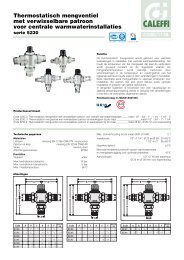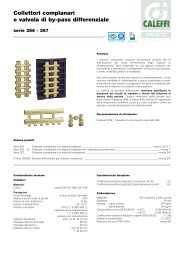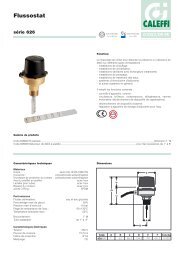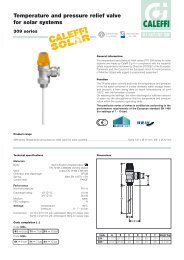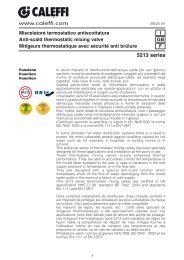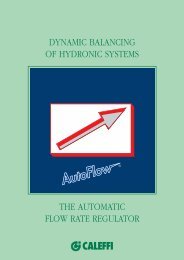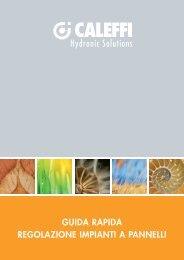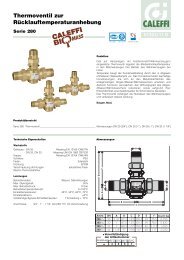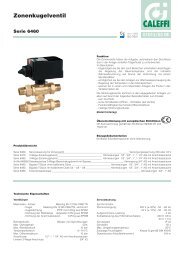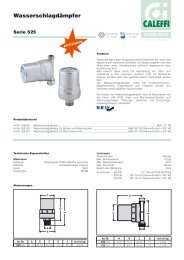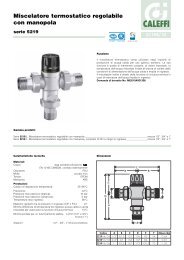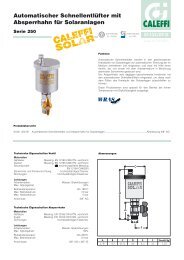Pressure reducing valve - Caleffi
Pressure reducing valve - Caleffi
Pressure reducing valve - Caleffi
You also want an ePaper? Increase the reach of your titles
YUMPU automatically turns print PDFs into web optimized ePapers that Google loves.
Operating principle<br />
The operating principle of the pressure <strong>reducing</strong> <strong>valve</strong> is based on<br />
the balance between two opposing forces: the thrust exerted by the<br />
downstream pressure on the lower part of the mobile <strong>valve</strong> is<br />
counteracted by the adjustable compression force of the spring.<br />
Since the active surface of the diaphragm is equivalent to the active<br />
surface of the mobile <strong>valve</strong>, the thrust which the upstream pressure<br />
exerts on the lower part of the diaphragm is compensated by the<br />
thrust exerted on the upper part of the mobile <strong>valve</strong>, thus rendering<br />
the appliance insensitive to changes in upstream pressure.<br />
When the pressure downstream of the <strong>reducing</strong> <strong>valve</strong> becomes<br />
lower than the regulating pressure, the force exerted by the spring<br />
becomes predominant and the obturator opens, increasing the<br />
degree of opening to increase the flow rate and restore the<br />
pressure (Fig. 1). However when the downstream pressure<br />
increases, the obturator closes, <strong>reducing</strong> the degree of opening to<br />
limit the flow rate. The downstream pressure therefore remains<br />
constant.<br />
1<br />
0<br />
2<br />
CALEFFI<br />
bar<br />
3<br />
4<br />
UPSTREAM DOWNSTREAM<br />
Fig.1<br />
Hydraulic characteristics<br />
1<br />
0<br />
2<br />
CALEFFI<br />
bar<br />
The following cavitation diagram can be used to check the<br />
operating conditions of the pressure <strong>reducing</strong> <strong>valve</strong>:<br />
Upstream pressure (bar)<br />
Downstream pressure (bar)<br />
3<br />
4<br />
Characteristic components<br />
11 Body<br />
12 Stem<br />
13 Seat<br />
14 Cover<br />
15 Lower cylinder<br />
16 Obturator holder<br />
17 Obturator stop<br />
18 Flange<br />
19 Mounting plate<br />
10 Guide cylinder<br />
11 Guide beat<br />
12 Adjustment spring<br />
18<br />
2<br />
17<br />
8<br />
15<br />
13<br />
7<br />
14<br />
6<br />
1<br />
0<br />
2<br />
CALEFFI<br />
bar<br />
3<br />
4<br />
13 Diaphragm<br />
14 Mobile <strong>valve</strong><br />
15 Guide ring<br />
16 Lower cylinder O-ring<br />
17 Non-removable nut<br />
18 Nut<br />
19 Cover fixing nut<br />
20 Setting screw<br />
21 Adjustment key<br />
22 <strong>Pressure</strong> gauge<br />
23 <strong>Pressure</strong> gauge cock<br />
Zone 1 : normal operating conditions<br />
Zone 2 : cavitation zone (use not recommended)<br />
Zone 3 : impossible<br />
Sizing<br />
The diameter of the appliance must be chosen based on the<br />
maximum flow rate and the conditions of use and not according the<br />
diameter of the pipe.<br />
The maximum flow rate is calculated considering an average<br />
velocity in the inflow section of 1,5 m/s.<br />
1<br />
0<br />
2<br />
CALEFFI<br />
bar<br />
DN 80 100 125 150 200<br />
Max. recommended<br />
flow rate (l/s)<br />
3<br />
4<br />
21<br />
20<br />
4<br />
9<br />
12<br />
22<br />
10<br />
23<br />
19<br />
16<br />
5<br />
3<br />
1<br />
11<br />
7,5 11,8 18,4 26,5 47,2



